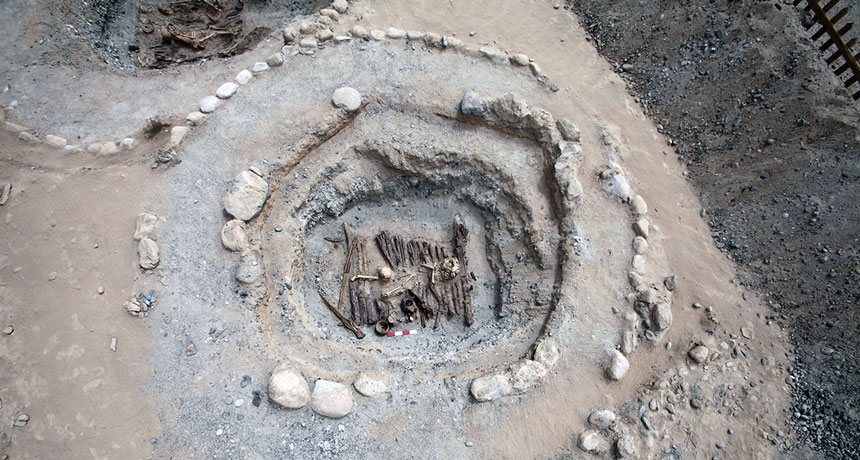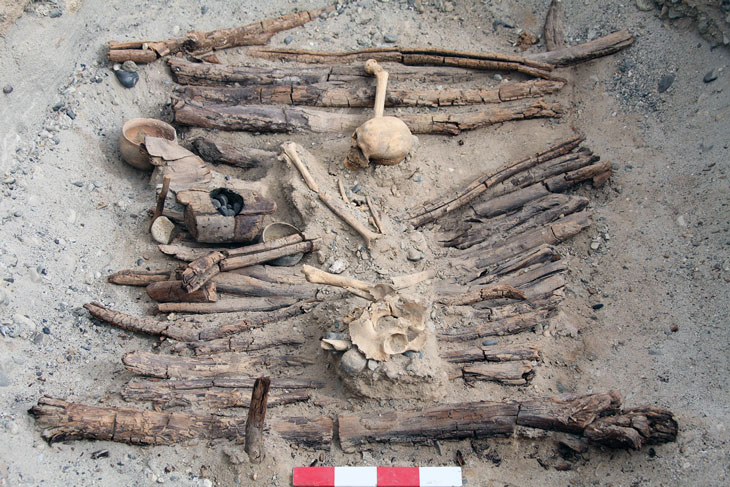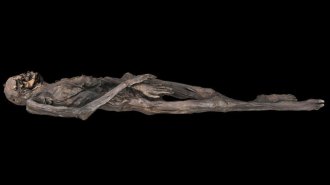People may have smoked marijuana in rituals 2,500 years ago in western China
Cannabis may have been altering minds at an ancient high-altitude cemetery, researchers say

SMOKED OUT Excavations of tombs such as this at a cemetery in western China yielded evidence that people burned cannabis and inhaled its fumes during rituals for the dead around 2,500 years ago.
Xinhua Wu
Mourners gathered at a cemetery in what’s now western China around 2,500 years ago to inhale fumes of burning cannabis plants that wafted from small wooden containers. High levels of the psychoactive compound THC in those ignited plants, also known as marijuana, would have induced altered states of consciousness.
Evidence of this practice comes from Jirzankal Cemetery in Central Asia’s Pamir Mountains, says a team led by archaeologist Yimin Yang of the University of Chinese Academy of Sciences in Beijing. Chemical residues on wooden burners unearthed in tombs there provide some of the oldest evidence to date of smoking or inhaling cannabis fumes, the researchers report online June 12 in Science Advances. Rituals aimed at communicating with the dead or a spirit world likely included cannabis smoking, the team speculates.
Cannabis remains of comparable age have been found in several other Central Asian tombs, including a site in Russia’s Altai Mountains located about 3,000 kilometers northwest of the Pamir Mountains. But the discoveries at Jirzankal Cemetery offer an unprecedented look at how cannabis was initially used as a mind-altering substance, the researchers say. East Asians grew cannabis starting at least 6,000 years ago, but only to consume the plants’ oily seeds and make clothing and rope out of cannabis fibers. Early cultivated cannabis varieties in East Asia and elsewhere, like most wild forms of the plant, contained low levels of THC and other mind-altering compounds.
Some of the earliest evidence for people smoking marijuana comes from the Greek historian Herodotus, who wrote of cannabis smoking roughly 2,500 years ago on the Central Asian steppes, about 2,000 kilometers west of the Pamir Mountains. But a determination of exactly when and where high-THC cannabis plants first developed and which people first smoked cannabis has long eluded scientists.

Crucially, high-elevation mountain passes of Central and East Asia, including the Pamir region, hosted trade routes of the early Silk Road, which linked China with West Asia and Europe, says archaeobotanist and study coauthor Robert Spengler of the Max Planck Institute for the Science of Human History in Jena, Germany. “Our study implies that knowledge of cannabis smoking and specific high-THC varieties of the cannabis plant were among the cultural traditions that spread along Silk Road exchange routes,” Spengler said at a June 11 news conference.
Archaeological finds indicate that many burial practices had spread across Central and East Asia by around 2,500 years ago. So cannabis smoking at graveside ceremonies was likely part of that process, says archaeologist Michael Frachetti of Washington University in St. Louis, who did not participate in the new study. “At that time, the early Silk Road connected populations from Beijing to Venice,” he says.
Given the new findings, Altai Mountain sites deserve closer scrutiny for clues to the origins of cannabis smoking, adds archaeologist David Anthony of Hartwick College in Oneonta, N.Y.
In support of the Pamir region as an ancient crossroads, earlier chemical analyses of human bones and teeth from Jirzankal Cemetery indicated that 10 of 34 individuals tested had grown up outside the area. Items placed in some Jirzankal tombs, such as silk fabrics from eastern China and a type of harp from West Asia, suggest that people from widespread cultures traveled to Central Asia.
Jirzankal Cemetery lies more than 3,000 meters above sea level. Black and white stone strips run across the site’s surface. Circular mounds of earth cover the tombs, which are lined by one or two rings of stones.
Yang’s team identified a chemical signature of cannabis on charred plant material from 10 wooden burners, or braziers, found in eight Jirzankal tombs. Chemical signs of an unusually high level of THC were found inside nine braziers and on two stones that had been heated and used to burn plants in the braziers.
Still, those ancient plants would have triggered less powerful psychoactive effects than present-day cannabis plants bred specifically for high THC levels, Spengler said.
It’s not known whether people who buried their dead at Jirzankal Cemetery cultivated high-THC cannabis plants or found a psychoactive variety that grew in the wild. Whatever the case, inhaling cannabis as part of mind-altering burial rituals probably began millennia before mourners gathered at Jirzankal’s tombs, Frachetti suspects.
Editor’s note: This story was updated June 12, 2019, to correct that Jirzankal Cemetery lies more than 3,000 meters above sea level, not kilometers.







